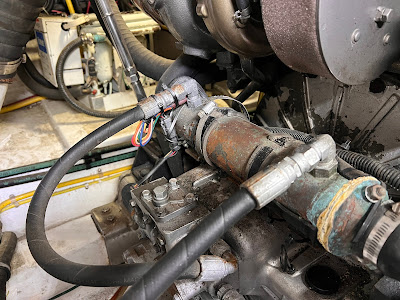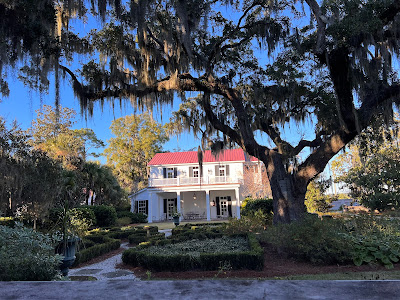 |
| Mike at the nerve center of the boat during start up: the electrical panel. |
So we got the keys. Step one complete! We had about a week before we had to leave. “Ralph”(1) kindly allowed us to stay in his slip until December 31. There were three key things to accomplish before kicking the tires and lighting the fires.
First, we needed to move on board. It was all a bit overwhelming. Why and when did our small mountains of items become so intimidating? How do we group things together and then find a logical place to put them? Ask my son and he will tell you I said often, “Everything has a place.” In a boat, it’s imperative because you can't have things out to roll around, or things to walk around.
Second, Mike needed to replace the two oil gear coolers which was the only critical to-do item from the survey. He would have preferred to hire a professional for this, but we didn't have enough time to get on a professional’s schedule. This took an afternoon.
 |
| The “before” picture. Note the corrosion. |
 |
| The “after” picture. |
Third, we (mostly Mike) needed to get familiar with all the key systems: engine, plumbing, HVAC, and electrical. He’s familiarized himself this way on three previous boats. And, at four houses, now that I think about it. There were systems and procedures unique to this boat. It's an uncomfortable but healthy challenge, IMHO, to get accustomed to a new boat that has familiar features, but in new places.
Via our broker, Mike sent an email with a dozen questions to Ralph. Putting it off until after Christmas weekend, our brokers arranged a phone call between Mike and Ralph. I listened in at first, but their conversation quickly surpassed my knowledge base so I left the boat and ran some errands.
We were a bit stressed feeling the pressure of having to get out of SC for tax consequences.
“How are you feeling now? We leave in two days,” I inquired.
“Well, I feel much better now that I talked to Ralph for a half hour. I learned a lot,” Mike admitted.
“A half-hour? Mike, you were on the phone for at least two hours!” Mike gave me a surprised look.
Ralph was quite patient and generous with his time. It was a very intense call. Time stood still for both of them.
“We will get to know the boat best just by running it,” I said.
“And the wind should be good for us for the next week,” agreed Mike. “Okay, let me start the engines now to make sure I know what to do.” Mike proceeded to kick the tires and light the fires(3). With a big smile and breath of relief, Mike shut down the engines and said, “It worked. It’s running!”
We were concerned about different things. Mike was worried that he would mis-step a start-up check or task, and I was worrried about how to pilot the boat.
As these final days raced by, we spoke a bit about where we would go. We knew we wanted to hang out in Florida until the Loopers begin heading North in March. On our trip down we could skip some legs of the ICW, which is long and winding, if we went out into the ocean. But this requires a good weather window. In the end, we decided to take longer and transit via the ICW since the boat is new to us and it would be easier to get help, if needed.
 |
| A page from the Great Loop Guide. You can see how there are relatively big gaps in the South Carolina to Mid-Florida cruise. We had to stop at in-between stops that didn't make it into the Guide. |
A final leave-it-behind step was to drop off our F150 truck at a storage facility we checked out before Christmas. Mike drove it into the storage shed and we waved it goodbye as we pulled down the door. Our local friend, Paula, dropped us off at the marina and then, we were carless. Boat transportation was our only alternative.
 |
| Mike captured our last moments as we said goodbye and thanks to Paula. You can also get an idea of the saloon, looking towards the galley. |
December 31 arrived and at 8:00 a.m. it was cold and clear. Mike went through his checklist and got the engines humming. Like we did with the Nordic Tug, we discussed the game plan for undocking. We donned our headsets and then removed all encumbrances from shore. Ever so slowly Mike put the boat in forward and there was no turning back.
 |
| After we left the marina a random gentleman at the end of a pier took a pic of us. I yelled out my cell number across the water and he sent it to me. Thus, we captured the beginning of our journey. |
Since that day we have had enjoyable daily cruises. Even though it’s been chilly, we’ve been warm in our fully enclosed flybridge. Mike gets all “A’s” from me for his first few docking jobs. The stabilizers make for a Cadillac-like cushy ride.
We will have to get used to the relatively shallow waters on the Atlantic ICW. The depth has been typically around 15 feet below our keel. In Puget Sound, we were regularly in hundreds of feet of water. Shallow waters automatically put us on high alert so have been glued to our navigation devices 100% of the time. The government-tended navigational aids in the ICW have been excellent so far. With our electronics, it's been a snap to know exactly where we are and where to aim next.
The video above shows the swift current moving through the marina. So far, this is a typical situation. It makes docking fairly sporty. There's not a lot of room for error or hesitation.
 |
| Typical view of the marshes and waterfront homes from our plastic-wrapped flybridge helm. |
The scenery hasn't changed much since we left Charleston. In the ICW of South Carolina and Georgia, also known as The Low Country, we glide through broad saltwater cordgrass marshes via creeks, rivers, and canals which are dredged periodically.
There is a steady stream of wildlife. In the sky are white and black pelicans, cormorants, grebes, cranes, and terns. Small, adorable grey dolphins regularly pop up, often in synchronized pairs, but surprisingly don't ride our wake. At Seabrook and Jekyll Islands, we spotted bald eagles soaring in circles.
It all feels very rural, like going up the Petaluma River in the Northern SF Bay Area. Winter is the off-season in this area. We see small, well-powered fishing boats every half hour or so.
 |
| Mike filled out the Captain Log at the end of the day, seated at the L-shaped settee. |
We felt a bit of trepidation as we approached our first night at anchor since we knew there would be a lot of current, and it was our first time using this boat’s anchoring tackle. (4) We found a good anchoring spot recommended by others right off the ICW “road.”
We fell into the same roles, responsibilities, and procedures that we had on the Nordic Tug. We discussed the game plan, donned our headsets, took our places (me at the anchor, Mike at the helm), and...we just had a minor issue. I briefly pressed the up anchor button when I should have pressed down. The fattish connecting piece got a little stuck at the narrow guiding piece forward of the winch. Mike came down from the flybridge perch and carefully pulled out the chain. No fingers lost. We were good to go.
Overall, Mike says, “I’m really pleased with the handling of the boat...going through wakes have been nothing!”
After a week we are still learning the boat systems. We haven't found homes for all of our stuff, either. We’re excited to get to warmer weather. We also need to find a good pausing stop in Florida to get the hull worked on, as we originally planned.
The overnight stops in our rearview mirror since Charleston:
- Bohicket Marina, Seabrook Island, SC
- B&B Seafood Dock, off the Ashepoo River, SC (They rent out dock space cheap--$40/night.)
- Beaufort Marina, Beaufort, SC
- Isle of Hope Marina, near Savannah, GA
- Back River, near Sapelo Island, GA (anchored)
- Jekyll Island, GA
FOOTNOTES FOR FUN FACT FANS
(1) Not the boat owner's real name.
(2) You may have heard the Southeast experienced multiple days of 3”-5” of rain daily after Christmas. We are fine in the boat during the rain. Everything is watertight.
(3) Mike has a nine-item checklist. It necessitates that he crawls into the engine room.
(4) Just like our Alaska trip, anchoring will be important for when we can't make it to a marina (e.g. it's too far between marinas), if marinas have no available spaces, or if we just want to save money.
BONUS PICS
Grand, enormous and stately seem to be the rule for marsh-front homes around here. Many have wharves leading the way out to covered docks. The homes I captured below look to be more than 3000 square feet. Most looked empty and we thought they were second homes.
Beaufort, SC, had a historic district that we enjoyed meandering through. Most of these houses were built between ~1800 and 1850. The original walls were built from tabby material. Tabby material is a combination of local sand, lime, and oysters.
We wanted to reveal our Ocean Alexander’s new name by now. But we're still removing the old name! I think we'll get there in a week. Here is Mike, in the cockpit, using a polishing compound on those old letters.













No comments:
Post a Comment
If you have a google account, you can post a comment. Otherwise, feel free to email us at eandmstern@gmail.com